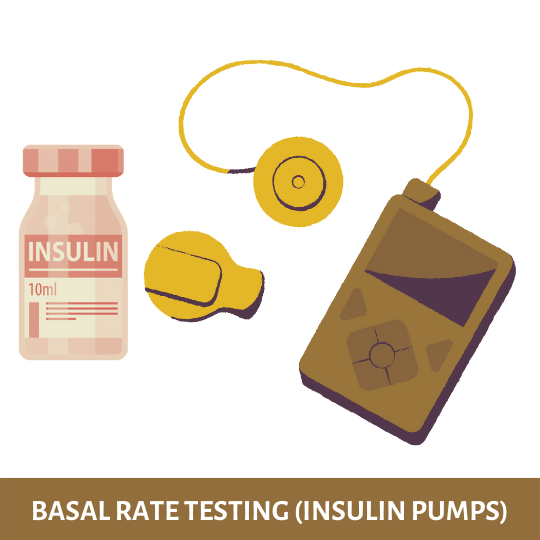Basal rate testing is a key part of setting up and adjusting an insulin pump. It helps you figure out how much insulin your body needs to keep your blood sugar levels stable overnight, during times of inactivity, or when sick.
There are a few different ways to test your basal rates. The most common method is to do a “fasting” test, where you don’t eat or drink anything except water for at least 8 hours before checking your blood sugar levels.
This is a step by step guide for performing a basal rate test for patients on insulin pump therapy.

How to do a basal rate test
One of the most important things to consider when using an insulin pump is the basal rate. The basal rate is the amount of insulin that is delivered over a period of time, typically 24 hours. This is the background or “basal” insulin that helps to keep blood sugar levels consistent throughout the day and night.
Basal rates can be different for every person and will need to be adjusted based on factors such as exercise, stress, illness, and changes in diet. It’s important to test your basal rates on a regular basis to make sure that your insulin pump is delivering the right amount of insulin for you.
Nutritional intake:
- While determining basal rates, it is important that meals are consistent in carbohydrates. Please weigh and measure all food or use foods with nutrition labels
- Eat a low-fat meal (either lunch or your evening meal) 4 hours before starting the basal test
- Do not eat during the testing period unless you develop a low blood sugar
- Water and diet beverages are allowed during the basal test
- No caffeinated beverages during the basal test
Bolus insulin
- Do not take insulin for at least 4 hours before the basal test. No active insulin
- Take insulin normally (do not extend the bolus) for the last meal/snack
- Do not take insulin during the test, unless your blood glucose is 200 or higher
Glucose
- No low blood sugar for at least 4 hours before starting the basal test
- No illnesses during basal rate testing (fever, infection, virus)
- No steroid medications being used
- Avoid basal rate testing when menstruating
Insulin considerations
- Do not put the pump into suspend
- Do not use a temporary basal rate
- Do not take a correction
- Do not disconnect from the pump
- Do not change the cartridge, tubing or infusion set during the test
Activity level:
- Perform usual daily activities during basal test. Including light exercise after your last meal. Avoid strenuous exercise
Testing blood glucose
- Start testing 4 hours after last insulin dose given for food or correction
- MOST IMPORTANTLY!
- Check blood glucose every 1-2 hours during daytime tests.
- Check blood glucose every 2-3 hours during overnight tests
- If blood glucose increases or decreases by 40 points than starting blood glucose stop the test.
STOP!
IF BLOOD GLUCOSE VALUE IS LESS THAN 70mg/dL STOP TEST AND TREAT LOW BLOOD GLUCOSE WITH 15 GRAMS CARBOHYDRATE. RETEST BLOOD GLUCOSE IN 15 MINUTES AND RE-TREAT with 15 grams of carbohydrate if not above 70mg/dL. Repeat if blood sugar is not above 70mg/dL.
When and How To Start a Basal Rate Test
- You did not have a low blood glucose earlier in the day.
- It has been at least four hours since you last took insulin for food or a correction.
- Check blood glucose. If blood glucose is between 100 – 160 start basal rate test.
- Skip meal, check blood glucose as directed. If blood glucose increases or decreases by 40 points from starting blood glucose stop the test, and treat or correct blood glucose value if indicated. Otherwise test is continued until the next meal time.
- Most importantly! Check blood glucose:
- every 1-2 hours during daytime tests
- Check blood glucose every 2-3 hours during overnight tests
- The entire day can be tested in this manner.
- Each meal will need to be skipped.
- DO NOT DO MORE THAN ONE BASAL TEST A DAY
Don’t worry if the test has to be discontinued. You did not fail. This is expected.
Examples of Basal Testing Outcomes
Night test
- Evening meal finished by 6 PM
- Blood sugar at 10:00 PM = 134. No snack
- Blood sugar at 1:00 AM = 122
- Blood sugar at 4:00 AM = 119
- Blood sugar at 6:00 AM = 110
No change is required. Glucoses stayed within 40 points.
Morning test
- Blood sugar at 6:30 AM = 156. Skip breakfast
- Blood sugar at 8:30 AM = 140
- Blood sugar at 10:30 PM = 70 mg/dL.
Stop test! Treat low blood sugar.
Disclaimer
The opinions expressed here represent the views of a practicing hormone specialist (endocrinologist) and must not substitute the advice of your health care provider. This blog post is written for a non-medical audience interested in learning more about hormonal disorders. The author has no commercial conflicts of interest to declare. Also, read our privacy policy.
Kindly Let Us Know If This Was helpful? Thank You!


